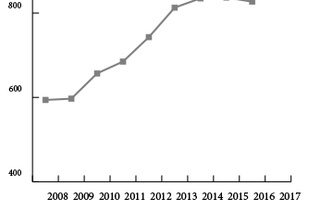For students like Murphy and Fiorenzoli, the pre-professional bent of the architecture studies track, far from undermining its legitimacy, is an asset. In Fiorenzoli’s case, the studio component was the deciding factor that led her to pursue the track. “The studio courses and the ability to make something that comes from yourself...[provide] proof of the theories you learn,” she says. “If the architecture track didn’t have those things, I wouldn’t have applied [to the program].”
BUILDING A RESUME
Architecture studies student Benjamin Lopez ’15 believes that the program’s attempt to reconcile theoretical and technical components has led to deficiency in the latter. “I expected a lot of my courses to be heavily design based and project based so you could build a portfolio,” Lopez says. “I was hoping to come out of Harvard with a few more projects, but what I found was the track doesn’t have too many design courses.”
Though Lopez does not intend to pursue a career as an architect, he is doubtful as to whether his undergraduate experiences would have provided sufficient preparation for an MArch program. “If you want to be an architect and have a comprehensive architecture education, Harvard is not the best place,” he says. “I feel that I don’t have the comprehensive skill sets a lot of students at competing schools do have…. Architecture programs and employers want to see what you’ve done, not your classes.”
{shortcode-d8c4bd3347042bbc840729b15724e02b71708ad6}
But how helpful a pre-professional undergraduate program is for aspiring architects remains unclear. According to Renée A. Caso, administrator for academic programs in the MIT Architecture Department, the criteria for admittance into the MIT MArch program are flexible. “I often see and notice that a lot of the students who apply and get into the program do not come from architecture programs,” she says. Caso also stresses that securing admission into a graduate program should not be the only goal of an undergraduate program in architecture studies. “To help students really decide whether or not [architecture] is the direction they want to go in is as equally important as training them for...an MArch program,” she says.
For some Harvard undergraduates, the architecture studies track has achieved this second objective, providing them with clarity about their professional ambitions and reaffirming their love for design. Murphy’s post-graduate experiences make clear that this love need not manifest in the form of a career as an architect. Since graduating in June as part of the first group to complete the track, Murphy has started working at Touch Of Modern, a startup that sells modern design items. “I knew after college that I wanted to be in the design world, but I didn’t know if I wanted to go to the graduate school,” Murphy says. “But one gap that I knew that I had in my knowledge of design was...design in terms of money.” While Murphy’s career has led her away from architecture, she cites her undergraduate studies as being influential in her job choice. “The concentration definitely secured my desire to be surrounded by design and to learn more about it,” she says.
ONE HARVARD
In addition to raising questions about the place of pre-professional studies at a liberal arts college, the required studio component of the architecture track necessitates close ties to GSD. The workshops and materials used by architecture track undergraduates were once used almost exclusively by graduate students. While the undergraduate track undoubtedly benefits from the wealth of resources available via the school, the connection between the track and the graduate school is not devoid of complications.
“Our interactions with the GSD are the highlight, but it’s not so fluid and seamless as it would seem,” Lopez says. “I wish we were more immersed in graduate classes, [and] I think we should take more…. The GSD is definitely opening their doors, [but] I guess you just get greedy and ambitious and wish the doors were more open.”
Fiorenzoli is thankful for the relationship between GSD and the History of Art and Architecture Department. “The whole environment gave me a really nice glimpse into the graduate school for architecture,” she says—a glimpse that has strongly influenced her decision to apply to graduate design school. However, she characterizes her personal connection to GSD and the HAA Department as unequal and acknowledges that the imbalance can be problematic. “I’ve made some really close connections with faculty at the GSD but less so with the HAA Department,” she says. “When I was looking at who would be my senior adviser for my thesis, I didn’t really know anyone at Harvard.”
Hays, too, admits that a seamless connection between GSD and the architecture studies track has been difficult to achieve. “[President Drew Faust] had a slogan...of ‘One Harvard,’” he says. “Her plan has been to bring together the different schools, including the graduate schools and the different departments in the College…. Despite the power of that plan, there’s such a built-in inertia to the institution.”
According to Hays, this inertia also contributed to the difficulty of making the architecture track a reality—an roughly three-year process that required an intensive approval process and concerted efforts on the part of both GSD and HAA faculty members. “The school as an institution has policies made to resist…connections and innovations,” Hays says. “It took a group of faculty working from the ground up and pushing it through the FAS processes…. There was a lot of emphasis on the combined efforts of two schools.”
ARCHITECTURE AS A MINDSET
Though many architecture studies students seem to view the track as a means of realizing a career in design, Hays is adamant that the program aligns with Harvard’s commitment to providing undergraduates with a liberal arts education—one that does not feed into a specific career. For Hays, architecture is not merely a discipline but a mindset. To study architecture is to develop a way of thinking and of seeing the world that is distinct from that cultivated by other areas of study.
Read more in Arts
Fall TV PreviewRecommended Articles
-
New GSD Program Aims To Get More ArchitectsBritish-based architectural firm RMJM recently donated $1.5 million to Harvard’s Graduate School of Design (GSD) in an attempt to increase
-
 Calvin Klein Shares Perspective on Design at GSD
Calvin Klein Shares Perspective on Design at GSD -
 Design School Building Draws Praise, Except For the Desk Space
Design School Building Draws Praise, Except For the Desk Space -
 Graduate School of Design's Enrollment Soars Skyward
Graduate School of Design's Enrollment Soars Skyward -
 Female Faculty at GSD Sign Statement Against Sexual, Racial Misconduct
Female Faculty at GSD Sign Statement Against Sexual, Racial Misconduct













